

Compact Muon Solenoid
LHC, CERN
| CMS-PAS-FTR-18-002 | ||
| Search sensitivity for dark photons decaying to displaced muons with CMS at the high-luminosity LHC | ||
| CMS Collaboration | ||
| October 2018 | ||
| Abstract: This note presents sensitivity studies for a search for pairs of displaced muons originating from long-lived dark photons using the Phase-2 CMS detector at the high-luminosity LHC with an integrated luminosity of 3000 fb−1. Projected sensitivities are obtained for broad ranges of dark photon masses (1-30 GeV) and lifetimes (cτ= 0.01 -10 m) in the context of Dark Supersymmetry models. | ||
| Links: CDS record (PDF) ; inSPIRE record ; CADI line (restricted) ; | ||
| Figures & Tables | Summary | Additional Figures | References | CMS Publications |
|---|
| Figures | |
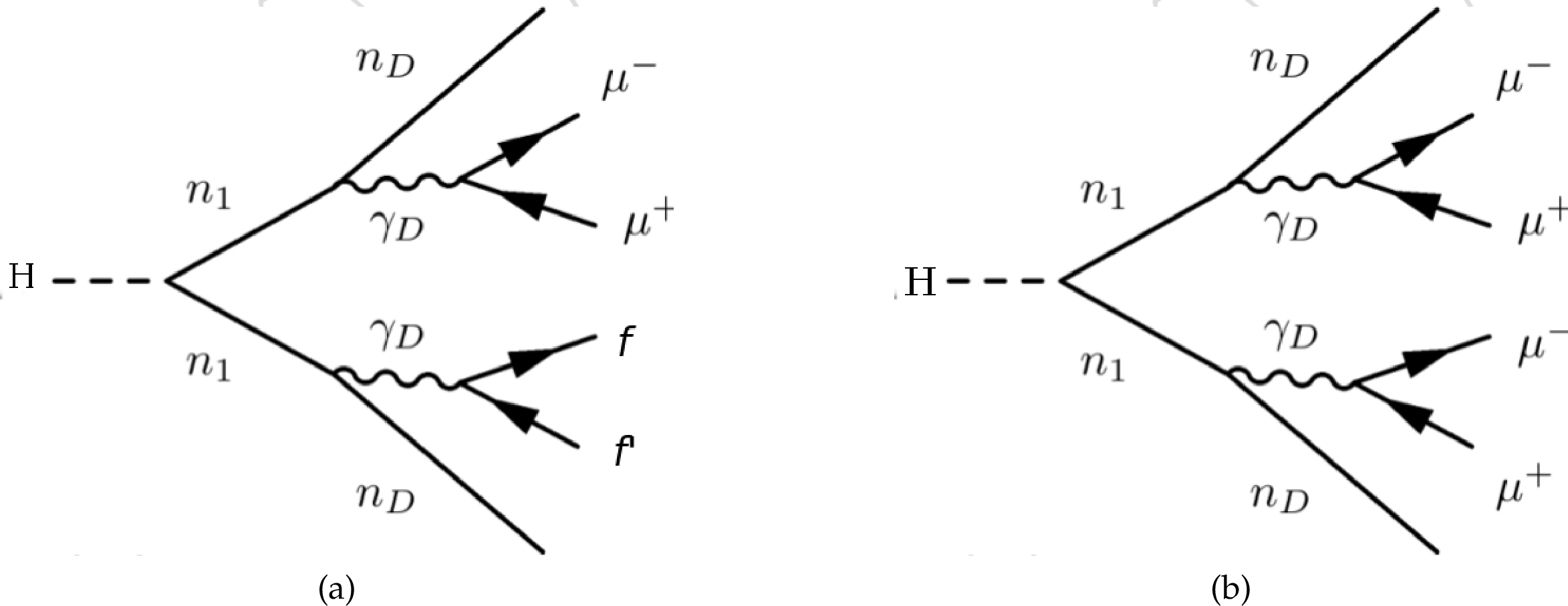
png pdf |
Figure 1:
Feynman diagram of the decay of SM Higgs boson to a final state containing two or more muons in Dark SUSY models [11]. (a) Decay chain leading to a final state containing exactly two muons. (b) Decay chain leading to a final state containing exactly four muons. |
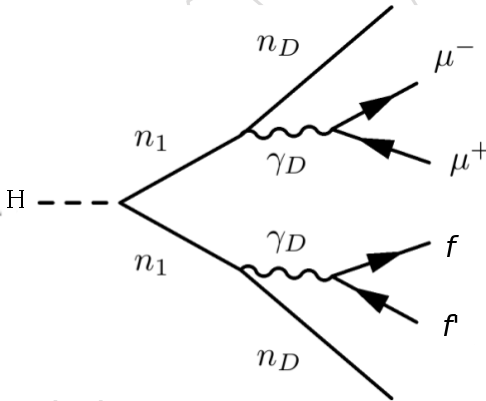
png |
Figure 1-a:
Feynman diagram of the decay of SM Higgs boson to a final state containing two or more muons in Dark SUSY models [11]. (a) Decay chain leading to a final state containing exactly two muons. (b) Decay chain leading to a final state containing exactly four muons. |

png |
Figure 1-b:
Feynman diagram of the decay of SM Higgs boson to a final state containing two or more muons in Dark SUSY models [11]. (a) Decay chain leading to a final state containing exactly two muons. (b) Decay chain leading to a final state containing exactly four muons. |
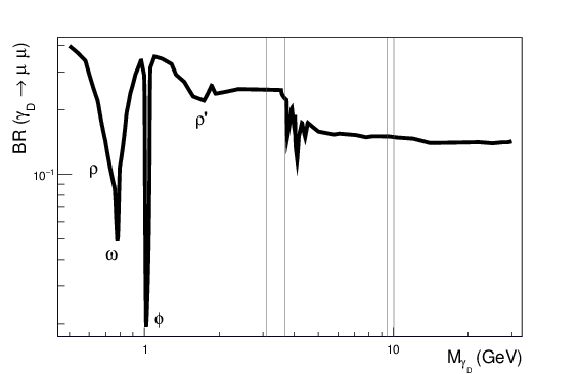
png pdf |
Figure 2:
Branching ratio of dark photons to muons. The branching ratio calculations include the impact of hadronic resonances, such as ρ, ω, ϕ and ρ′, as well as other leptonic decay modes of the dark photon. Narrow hadronic resonances (e.g. Υ,J/ψ and ψ(2S)), which are shown as gray areas, do not enter the branching ratio calculations. |

png pdf |
Figure 3:
Event display of a tˉt event with high pileup. All reconstructed muons fulfilling pT> 1 GeV are shown. Muons from pileup are predominantly in the forward region of the detector. The tracks going horizontally through detector with no origin at the center of the detector are muons from beam halo. Both types of muons, from pileup and beam halo, are very low-pT objects and are rejected by the muon pT criterion applied in the analysis. |
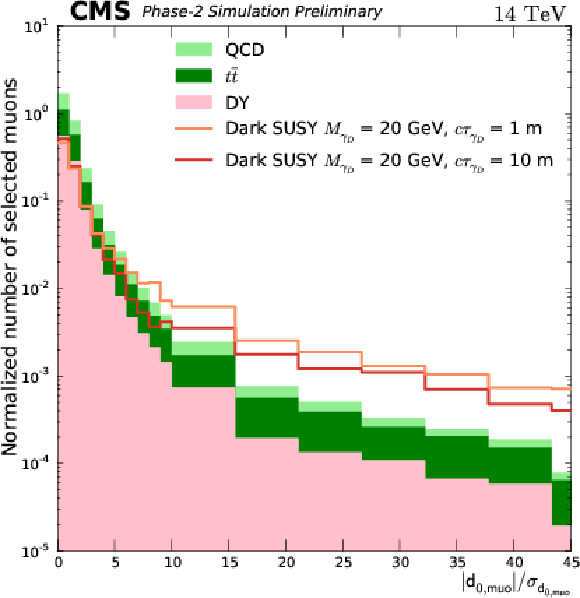
png pdf |
Figure 4:
Distribution of the significance of the transverse impact parameter, ∘limiter69640972d0∘limiter86418188/σ(d0), for signal and background samples. Displaced standalone muons passing the kinematic selection (pT and η) of the object selection are shown. |
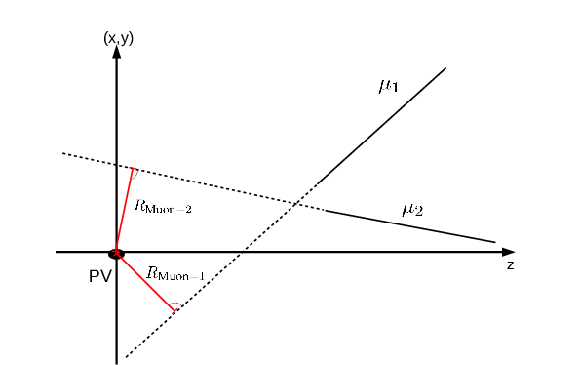
png pdf |
Figure 5:
Sketch illustrating the three dimensional distances of the closest approach of the displaced muon track to the primary interaction vertex, RMuon-1 and RMuon-2, for the two selected muons. PV denotes the primary interaction vertex. (x,y) illustrates the transverse plane and the z-axis is along the beam line. |

png pdf |
Figure 6:
Distribution of the distance of the closest approach of the displaced muon track to the primary interaction vertex, RMuon−1, for signal and background samples after the final event selection. The distance of the highest pT muon is shown. |
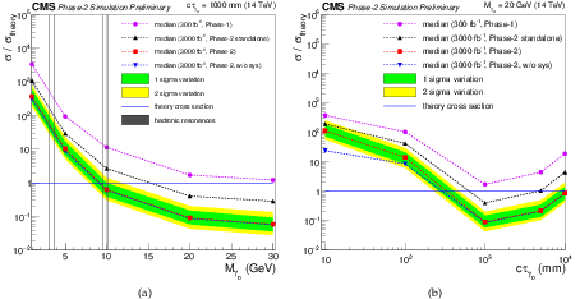
png pdf |
Figure 7:
95% CL upper limits on production cross section σ/σtheory for various dark photon mass hypotheses and a fixed decay length of cτ= 1000 mm (a) and a fixed mass of MγD= 20 GeV as a function of the dark photon decay length (b). Green and yellow shaded bands show the one and two sigma range of variation of the expected 95% CL limits, respectively. Phase-2 results with 3000 fb−1 (red) are compared to results obtained with 300 fb−1 (violet) of integrated luminosity, which corresponds to the end of Phase-1 data taking. Another median of an excluded limit is shown here which represents the scenario with the reduced standalone reconstruction efficiency with 3000 fb−1 (black) of integrated luminosity. Additionally, Phase-2 results with 3000 fb−1 are determined without any systematic uncertainties (blue). The theoretical Dark SUSY cross section for 14 TeV is shown as a solid line. The gray lines indicate the regions of narrow hadronic resonances where the analysis does not claim any sensitivity (see Fig. 2). |

png pdf |
Figure 7-a:
95% CL upper limits on production cross section σ/σtheory for various dark photon mass hypotheses and a fixed decay length of cτ= 1000 mm (a) and a fixed mass of MγD= 20 GeV as a function of the dark photon decay length (b). Green and yellow shaded bands show the one and two sigma range of variation of the expected 95% CL limits, respectively. Phase-2 results with 3000 fb−1 (red) are compared to results obtained with 300 fb−1 (violet) of integrated luminosity, which corresponds to the end of Phase-1 data taking. Another median of an excluded limit is shown here which represents the scenario with the reduced standalone reconstruction efficiency with 3000 fb−1 (black) of integrated luminosity. Additionally, Phase-2 results with 3000 fb−1 are determined without any systematic uncertainties (blue). The theoretical Dark SUSY cross section for 14 TeV is shown as a solid line. The gray lines indicate the regions of narrow hadronic resonances where the analysis does not claim any sensitivity (see Fig. 2). |
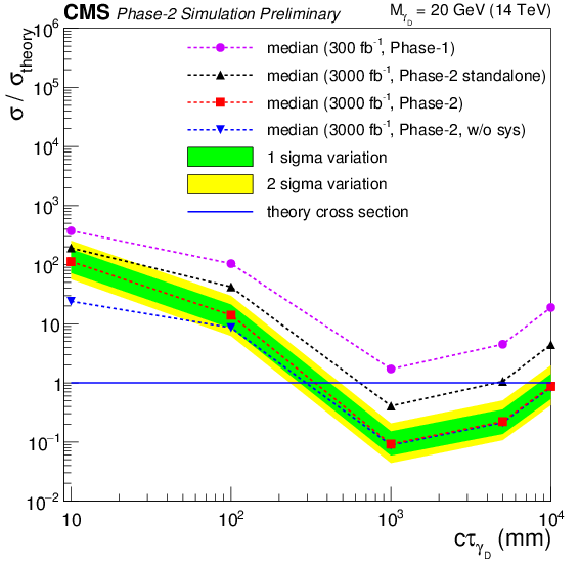
png pdf |
Figure 7-b:
95% CL upper limits on production cross section σ/σtheory for various dark photon mass hypotheses and a fixed decay length of cτ= 1000 mm (a) and a fixed mass of MγD= 20 GeV as a function of the dark photon decay length (b). Green and yellow shaded bands show the one and two sigma range of variation of the expected 95% CL limits, respectively. Phase-2 results with 3000 fb−1 (red) are compared to results obtained with 300 fb−1 (violet) of integrated luminosity, which corresponds to the end of Phase-1 data taking. Another median of an excluded limit is shown here which represents the scenario with the reduced standalone reconstruction efficiency with 3000 fb−1 (black) of integrated luminosity. Additionally, Phase-2 results with 3000 fb−1 are determined without any systematic uncertainties (blue). The theoretical Dark SUSY cross section for 14 TeV is shown as a solid line. The gray lines indicate the regions of narrow hadronic resonances where the analysis does not claim any sensitivity (see Fig. 2). |

png pdf |
Figure 8:
Parameter scan in the ϵ−mγD plane. (a) Collection of existing limits taken from Ref. [8]. (b) Results from this analysis for Phase-2 with 3000 fb−1. The ranges with exclusion and discovery sensitivity are shown in light and dark red color, respectively. The gray lines indicate the regions of narrow hadronic resonances where the analysis does not claim any sensitivity (see Fig. 2). |

png pdf |
Figure 8-a:
Parameter scan in the ϵ−mγD plane. (a) Collection of existing limits taken from Ref. [8]. (b) Results from this analysis for Phase-2 with 3000 fb−1. The ranges with exclusion and discovery sensitivity are shown in light and dark red color, respectively. The gray lines indicate the regions of narrow hadronic resonances where the analysis does not claim any sensitivity (see Fig. 2). |
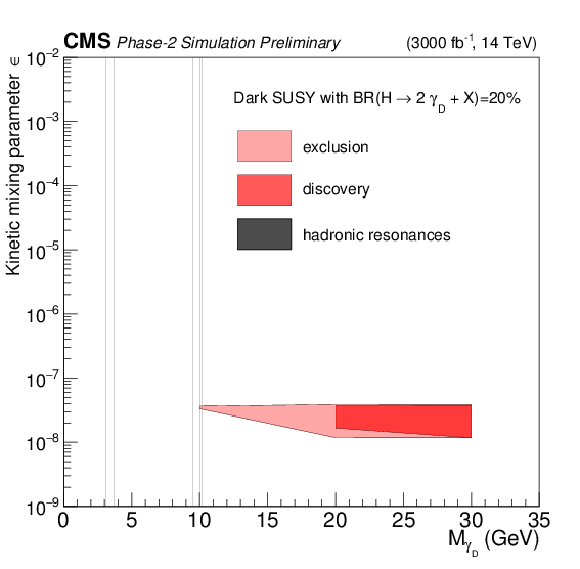
png pdf |
Figure 8-b:
Parameter scan in the ϵ−mγD plane. (a) Collection of existing limits taken from Ref. [8]. (b) Results from this analysis for Phase-2 with 3000 fb−1. The ranges with exclusion and discovery sensitivity are shown in light and dark red color, respectively. The gray lines indicate the regions of narrow hadronic resonances where the analysis does not claim any sensitivity (see Fig. 2). |

png pdf jpg |
Figure 9:
Feynman diagram of the process leading to smuon pair production at a hadron collider. The decay of the smuons leads to the final state including two muons. |

png pdf |
Figure 10:
(a) Discovery significance and p-value for a fixed smuon mass of M˜μ= 200 GeV. (b) Discovery sensitivity in the parameter space of mass and decay length. |

png pdf |
Figure 10-a:
(a) Discovery significance and p-value for a fixed smuon mass of M˜μ= 200 GeV. (b) Discovery sensitivity in the parameter space of mass and decay length. |

png pdf |
Figure 10-b:
(a) Discovery significance and p-value for a fixed smuon mass of M˜μ= 200 GeV. (b) Discovery sensitivity in the parameter space of mass and decay length. |
| Tables | |

png pdf |
Table 1:
Signal and background event yields with statistical uncertainties in different search regions after the final event selection. The systematic uncertainties can be found in Sec. 8. |
| Summary |
|
Present searches for displaced muons show no significant deviation with respect to the standard model expectation. However, there is quite a large phase-space which has not been explored yet and is unreachable with the current LHC conditions due to low signal cross sections and limited statistics. The high-luminosity LHC will provide a unique opportunity to search for new physics with a striking signature of highly displaced muons. This study presents the search sensitivity for pairs of displaced muons with an integrated luminosity of 3000 fb−1. The transverse impact parameter significance and the three-dimensional distance between the extrapolated displaced muon track and the primary vertex are used as the discriminating variables in the search for two largely displaced muons that are reconstructed with a standalone algorithm using only muon chamber hits. The search in this note is performed within a model belonging to a class of Dark SUSY models where dark photons decay into a pair of displaced muons. The study shows that searches at the high-luminosity LHC will be able to probe phase-space which has not been explored yet. |
| Additional Figures | |
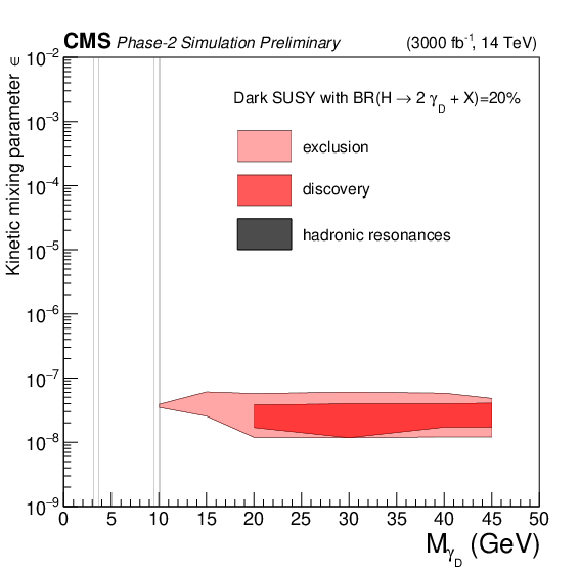
png pdf |
Additional Figure 1:
Exclusion and discovery sensitivity of the search for dark photons for the Phase-2 CMS detector and an integrated luminosity of 3000 fb−1. The search is assuming B(H→2γD+X)= 20%. The sensitive regions are shown in light and dark red color for exclusion and discovery, respectively. The gray lines indicate the regions of narrow hadronic resonances where the analysis does not claim any sensitivity. New points in the dark photon mass and lifetime parameter space are included compared to previous results. This extends the investigated mass range up to MγD= 45 GeV. |
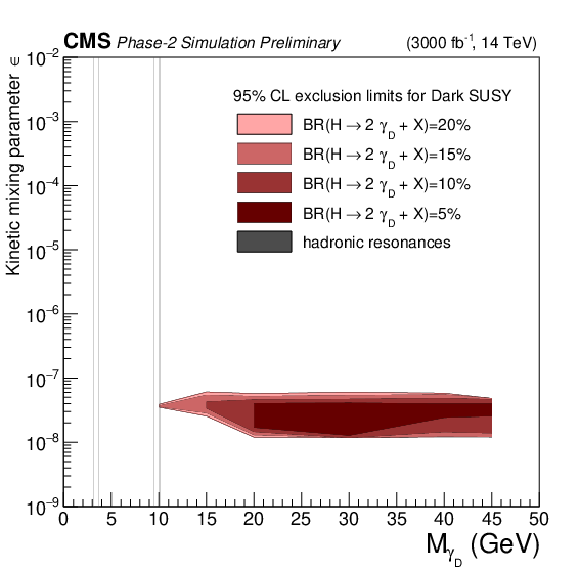
png pdf |
Additional Figure 2:
Exclusion sensitivity of the search for dark photons for the Phase-2 CMS detector and an integrated luminosity of 3000 fb−1. The different shades of red indicate the sensitive areas for different values of B(H→2γD+X). The gray lines indicate the regions of narrow hadronic resonances where the analysis does not claim any sensitivity. |
| References | ||||
| 1 | CMS Collaboration | CMS Technical Design Report for the Muon Endcap GEM Upgrade | CDS | |
| 2 | CMS Collaboration | The Phase-2 Upgrade of the CMS Muon Detectors | CDS | |
| 3 | M. Baumgart et al. | Non-Abelian Dark Sectors and Their Collider Signatures | JHEP 04 (2009) 014 | 0901.0283 |
| 4 | A. Falkowski, J. T. Ruderman, T. Volansky, and J. Zupan | Hidden Higgs Decaying to Lepton Jets | JHEP 05 (2010) 077 | 1002.2952 |
| 5 | CMS Collaboration | CMS. CERN, Geneva | ||
| 6 | R. Fruhwirth | Application of kalman filtering to track and vertex fitting | NIMA 262 (1987) 444 -- 450 | |
| 7 | CMS Collaboration | Muon Reconstruction and Identification Improvements for Run-2 and First Results with 2015 Run Data | CDS | |
| 8 | CMS Collaboration | A search for pair production of new light bosons decaying into muons at √s= 13 TeV | CMS-PAS-HIG-18-003 | |
| 9 | CMS Collaboration | Searches for invisible decays of the Higgs boson in pp collisions at √s= 7, 8, and 13 TeV | JHEP 02 (2017) 135 | CMS-HIG-16-016 1610.09218 |
| 10 | LHC Higgs Cross Section Working Group Collaboration | Handbook of LHC Higgs Cross Sections: 1. Inclusive Observables | 1101.0593 | |
| 11 | CMS Collaboration | A Search for Beyond Standard Model Light Bosons Decaying into Muon Pairs | CMS-PAS-HIG-16-035 | |
| 12 | T. Sjostrand, S. Mrenna, and P. Z. Skands | A Brief Introduction to PYTHIA 8.1 | Comp. Phys. Comm. 178 (2008) 852--867 | 0710.3820 |
| 13 | T. Sjostrand et al. | An introduction to PYTHIA 8.2 | Comp. Phys. Comm. 191 (2015) 159 | 1410.3012 |
| 14 | J. Alwall et al. | The automated computation of tree-level and next-to-leading order differential cross sections, and their matching to parton shower simulations | JHEP 07 (2014) 079 | 1405.0301 |
| 15 | P. Nason | A new method for combining NLO QCD with shower Monte Carlo algorithms | JHEP 11 (2004) 040 | hep-ph/0409146 |
| 16 | S. Frixione, P. Nason, and C. Oleari | Matching NLO QCD computations with parton shower simulations: the POWHEG method | JHEP 11 (2007) 070 | 0709.2092 |
| 17 | S. Alioli, P. Nason, C. Oleari, and E. Re | A general framework for implementing NLO calculations in shower Monte Carlo programs: the POWHEG BOX | JHEP 06 (2010) 043 | 1002.2581 |
| 18 | CMS Collaboration | Event generator tunes obtained from underlying event and multiparton scattering measurements | EPJC 76 (2016) 155 | CMS-GEN-14-001 1512.00815 |
| 19 | GEANT4 Collaboration | GEANT4: A Simulation toolkit | NIMA 506 (2003) 250--303 | |
| 20 | C. Liu et al. | Reconstruction of cosmic and beam-halo muons with the CMS detector | EPJC 56 (Aug, 2008) | |
| 21 | CMS Collaboration | Search for displaced leptons in the e-mu channel | CMS-PAS-EXO-16-022 | |
| 22 | CMS Collaboration | Projected performance of Higgs analyses at the HL-LHC for ECFA 2016 | CMS-PAS-FTR-16-002 | CMS-PAS-FTR-16-002 |
| 23 | CMS Collaboration | Search for lepton-flavor violating decays of heavy resonances and quantum black holes to eμ final states in proton-proton collisions at √s= 13 TeV | JHEP 04 (2018) 073 | CMS-EXO-16-058 1802.01122 |
| 24 | CMS Collaboration | Search for a high-mass resonance decaying into a dilepton final state in 13 fb−1 of pp collisions at √s= 13 TeV | CMS-PAS-EXO-16-031 | |
| 25 | CMS Collaboration | Updates on Search Sensitivity for New particles at HL-LHC | CMS-PAS-FTR-16-005 | |
| 26 | CMS Collaboration | The Phase-2 Upgrade of the CMS L1 Trigger Interim Technical Design Report | CDS | |
| 27 | ATLAS Collaboration | Search for long-lived neutral particles decaying into lepton jets in proton-proton collisions at √s= 8 TeV with the ATLAS detector | JHEP 11 (2014) 088 | 1409.0746 |
| 28 | CMS Collaboration | Search for Light Resonances Decaying into Pairs of Muons as a Signal of New Physics | JHEP 07 (2011) 098 | CMS-EXO-11-013 1106.2375 |
| 29 | KLOE-2 Collaboration | Search for light vector boson production in e+e−→μ+μ−γ interactions with the KLOE experiment | PLB 736 (2014) 459--464 | 1404.7772 |
| 30 | BaBar Collaboration | Search for a Dark Photon in e+e− Collisions at BaBar | PRL 113 (2014), no. 20, 201801 | 1406.2980 |
| 31 | PHENIX Collaboration | Search for dark photons from neutral meson decays in p+p and d + Au collisions at √sNN= 200 GeV | PRC 91 (2015), no. 3, 031901 | 1409.0851 |
| 32 | J. B. Dent, F. Ferrer, and L. M. Krauss | Constraints on Light Hidden Sector Gauge Bosons from Supernova Cooling | 1201.2683 | |
| 33 | S. Ambrosanio, G. D. Kribs, and S. P. Martin | Signals for gauge mediated supersymmetry breaking models at the CERN LEP-2 collider | PRD 56 (1997) 1761--1777 | hep-ph/9703211 |

|
Compact Muon Solenoid LHC, CERN |

|

|

|

|

|

|